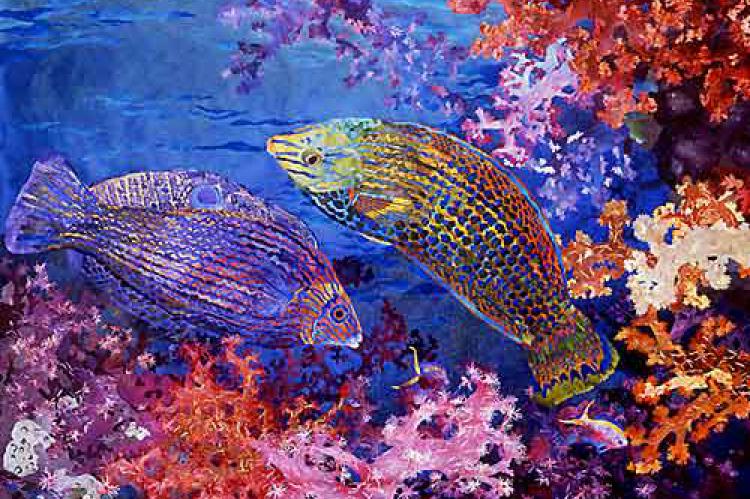Amanda Richardson Portfolio
Few fine artists have been able to marry the sensuous nature of luxurious textiles with the luscious diversity of underwater realm as well as Amanda Richardson.
Tags & Taxonomy
In Richardson’s works, there is a strong sense of place. She left Cornwall in 1986 and spent ten years in the Pacific Northwest of the United States. There, on San Juan Island north of the Puget Sound off the state of Washington, she gained insight and inspiration from the dramatic landscapes that surrounded her. From the mountains to the sea, the islands gave her much to explore in nature and in art.
It was here and in further travels beyond—to various places such as Alaska, New Zealand, Tonga, the Cook Islands and Fiji—where Richardson discovered snorkelling and became enchanted by the beauty of the coral reefs.
Richardson said that her artwork has always described the nuances of the natural world. So, it was no surprise that the complex patterns and brilliant colours of the tropical waters she explored in her travels found their way into her artwork.
Upon returning to San Juan, Richardson received a commission from the marine laboratories, at the University of Washington, to create a textile collage inspired by the diverse marine life found around the San Juan Islands. In contrast to the warm tropical waters from which she had just come, the San Juan Islands had deep and cold waters, surrounding what were once ancient mountain tops.
Connection to the sea
Richardson said that she has always lived near the sea and that the shapes and patterns of water have always played an important part in her art. In particular, were the sculptural forms of waves as they crashed upon the shore. With this theme in mind, she created a series of works, which focused on the movement of waves.
In addition, she gained inspiration from how forces in nature acted upon the terrain and living things. Artworks resulted, which reflected Richarson’s fascination with how plants grew in their indigenous environments and how rocks were shaped by water and wind.
Richardson then expanded her subject matter to include creatures in nature such as birds and insects. Richardson said that they are an integral part of her wild garden, a garden which has become part of her working process.
Method
Richardsen described the elaborate process by which each of her textile collages were created. She said that preparation for each work started with the selection of fabrics. These were then hand dyed. Glue was then applied to the reverse side of the fabrics, which held the weave of the material together. This was an important step to do so that the fabrics could be cut into complex shapes. The cut shapes were then built up, layer upon layer, on a backing fabric, until the image was complete. Finally, the glue that held the cut fabrics and the collage together was then fixed by steam.
Commissions and exhibitions
Richardson’s artworks come in various sizes. She creates pieces that suit domestic interiors as well as large-scale artworks for public buildings. In 1975, Richardson got her first major commission. To celebrate the 400th anniversary of the Bath family at Longleat House, England, the Royal School of Needlework asked her to create a large-scale work. So, she created a large embroidered fabric collage, which measured 9x7ft. Other commissions followed from American corporate clients such as Boeing, the Universities of Alaska and Washington State, the chemical company BASF, Marriott Hotels, Hilton Hotels, and the Waldorf Astoria.
Across America from New York to California, Richardson has held one-man exhibitions, as well as exhibitions in Britain from Cumbria to London and Cornwall. She shows her work on an ongoing basis in several galleries with which she has held long-standing relationships.
You can visit Richardson at her studio in Cornwall or get more information about the artist and her artwork online at: www.amandarichardson.co.uk ■
Download the full article ⬇︎
Originally published
X-Ray Mag #52
Diving Spain's Costa Brava; Honduras' Roatan; Micronesia's Kosrae & Pohnpei; Diving Gulen, Norwegian fjord; Kids Scuba Malaysia Mabul-Sipadan Camp; Jim Hellemn profile; Why scientific diving safer; Diving the Mesoamerican Barrier Reef; Dive fitness: The Clock; Tech: 10 tips on going pro; When sharks really attack; All about mirrorless cameras lenses; Amanda Richardson portfolio; Plus news and discoveries, equipment and training news, books and media, underwater photo and video equipment, turtle news, shark tales, whale tales and much more...






























